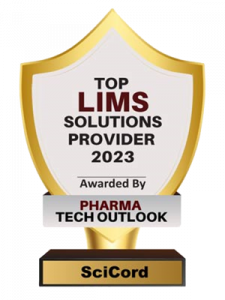Introduction
SciCord will develop robust and reliable software templates that not only meet our customers’ current requirements but also adapt to future needs and challenges effectively. Regular evaluation and improvement based on testing outcomes and user feedback are key to maintaining high standards of quality and usability. Transitioning software compliantly involves several key steps to ensure a smooth and effective process:
- Data Migration and Management
- Testing and Validation
- Training and Documentation
- Compliance Audits and Reviews
What it means to be FDA Compliant:
When it comes to pharmaceutical computer software assurance, the FDA (U.S. Food and Drug Administration) focuses on ensuring that software used in pharmaceutical manufacturing, testing, and distribution meets certain standards of quality, reliability, and regulatory compliance. Here are some key aspects of FDA pharmaceutical computer software assurance:
- Current Good Manufacturing Practices (cGMP): Pharmaceutical manufacturers must adhere to cGMP regulations, which include requirements for the control and documentation of software used in manufacturing processes. This ensures that software-related activities, such as batch records, electronic signatures, and process controls, meet regulatory standards.
- Data Integrity: The FDA emphasizes the importance of data integrity in pharmaceutical software systems. This includes ensuring that data generated, processed, and stored by software systems are accurate, dependable, and attributable throughout their lifecycle.
- Validation: Pharmaceutical companies are required to validate computer software used in GMP activities to demonstrate that it performs as intended, meets user requirements, and complies with regulatory requirements. This validation process typically includes installation qualification (IQ), operational qualification (OQ), and performance qualification (PQ).
- Electronic Records and Signatures: Software systems that handle electronic records and electronic signatures (ERES) must comply with FDA regulations outlined in 21 CFR Part 11. This includes requirements for system validation, audit trails, data security, and controls to prevent unauthorized access or modifications.
- Risk Management: Like medical devices, pharmaceutical software systems must undergo risk management processes to identify and mitigate potential risks associated with software failures, data integrity issues, and regulatory non-compliance.
Overall, FDA pharmaceutical computer software assurance aims to ensure the reliability, security, and regulatory compliance of software systems used in pharmaceutical manufacturing, testing, distribution, and other related activities. Pharmaceutical companies must implement and maintain effective software assurance practices to ensure product quality and patient safety. This is where the SciCord Platform team can help ease your transition to a validated environment.
The SciCord Platform Path to Compliance
Define the Purpose and Scope
Identify Use Cases
Use cases help determine the specific scenarios and involves understanding the target audience and their requirements.
Scope
Our team works together with you, our customer, in defining the functionalities, features, and components that the template will include. This helps in setting clear boundaries for what the template will deliver. Here are key aspects to consider:
- Core Functionalities: Identify the essential features that the template must provide for the customers’ needs.
- Optional Features: Determine additional functionalities that can be optionally included or configured based on specific project needs. Examples include email notifications, file uploads, role-based access control, etc.
- Documentation: Plan for comprehensive documentation that explains how to use the template, configure it, and extend its functionalities.
By thoroughly defining use cases and scoping the template’s functionalities, SciCord can ensure that the template meets the specific needs of its intended users effectively and efficiently. This approach also helps in managing expectations and providing clarity during the development and deployment phases.
Template Content Development
This involves working closely with the customer and designing templates that effectively perform the duties that are set by the user requirements. This requires customer feedback to ensure that the template/s aesthetic and functionality match the customer requirements.
Testing and Validation
By following a structured approach to testing, including thorough validation, risk assessment, and adherence to requirements, SciCord can ensure that the software template is robust, dependable, and meets the needs of its intended users effectively. Regular updates and maintenance based on feedback and new requirements will further enhance its usability and reliability over time.
The SciCord team is well versed in Installation Qualification (IQ), Operational Qualification (OQ), and Performance Qualification (PQ), which are validation protocols used in various industries, especially pharmaceuticals, biotechnology, and medical devices. Here is a brief overview of each:
- Installation Qualification (IQ):
- IQ ensures that equipment or systems are installed correctly and according to their specifications.
- It verifies that all components are delivered as designed and specified, and that they are installed in the intended environment.
- Operational Qualification (OQ):
- OQ verifies that the equipment or system operates as intended throughout all anticipated operating ranges.
- It ensures that the equipment functions correctly when subjected to specified operating conditions, such as upper and lower limits of operational parameters.
- Performance Qualification (PQ):
- PQ demonstrates that the equipment or system consistently performs according to predefined criteria over an extended period, typically using actual product or process materials.
- It verifies that the equipment, when used in routine production or operation, produces consistent results within specified limits.
These protocols are crucial for ensuring that equipment, systems, and processes meet quality standards and regulatory requirements before they are used in production or other critical applications. Constant communication with all stakeholders involved is crucial to successful implementation.
Documentation Included for a Validated Environment
Creating documentation for a validated software environment is crucial to ensure compliance with regulatory requirements and to maintain the integrity of the validated state. SciCord can create thorough documentation for a validated software environment that meets regulatory standards and supports ongoing compliance efforts.
TIP/TIR
- Technical Installation Plan: Document the installation
- Technical Installation Report: Record any issues encountered during installation, including their impact, steps to reproduce, and resolutions.
Risk Assessment
- Identify Risks: Evaluate potential risks associated with using the template and apply risk level assessment.
- Mitigation: Develop strategies to mitigate identified risks, conducting thorough testing, or providing clear documentation.
Requirements
- Functional Requirements: Ensure the template meets all specified functional requirements.
Summary Report
- Testing Results: Summarize the outcomes of testing, including any incidents found, their severity, and their resolutions. This will also include Template History, Documentation List, Contents of the template index, Requirement Test Matrix, and Installation Requirements.
- Compliance: Ensure the template complies with relevant standards, guidelines, or regulations applicable to its use case.
By following these steps and practices, SciCord will develop effective software templates that save time, promote consistency, and improve the overall quality of software development within your organization or community.
Implementation and Training
Implementing software templates involves developing the actual content of the template itself and providing comprehensive documentation to guide users on its usage and customization. SciCord will be able to handle all your needs for all required documents as well as training your team.





Recent Comments